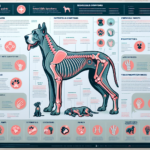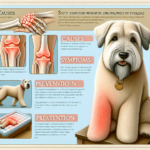Brussels Griffon Joint Pain: Causes, Symptoms, Prevention, and Treatment
Introduction
The Brussels Griffon is a small, charming breed known for its expressive face and lively personality. Originating from Belgium, this breed was initially bred to hunt and kill vermin in stables. Over time, the Brussels Griffon has evolved into a beloved companion dog, admired for its intelligence, affectionate nature, and distinctive appearance, which includes a prominent beard and large, soulful eyes.
Like many purebred dogs, the Brussels Griffon is prone to certain health issues. Among these, joint pain is a significant concern that can affect the quality of life for these small dogs. Joint health is particularly crucial for the Brussels Griffon due to their active nature and the potential for genetic predispositions to joint-related problems.
Breed-Specific Joint Pain Risks
Genetic Predisposition
The Brussels Griffon, like many small breeds, can be genetically predisposed to joint issues such as hip dysplasia, patellar luxation, and arthritis. Hip dysplasia, although more common in larger breeds, can still affect smaller dogs and lead to significant discomfort and mobility issues. Patellar luxation, where the kneecap dislocates or moves out of its normal position, is particularly common in small breeds and can cause intermittent lameness and pain.
Age-Related Risks
As the Brussels Griffon ages, the risk of developing joint pain increases. Degenerative joint diseases such as osteoarthritis can develop over time, leading to chronic pain and reduced mobility. Owners should be vigilant as their dogs reach middle age (around 5-7 years) and older, watching for signs of joint discomfort and stiffness.
Activity Level and Joint Stress
The Brussels Griffon is an active and playful breed, often engaging in vigorous activities that can put stress on their joints. While regular exercise is essential for maintaining overall health, excessive or high-impact activities can exacerbate joint issues. Owners should balance their dog’s activity level to prevent undue stress on their joints.
Common Symptoms of Joint Pain in Brussels Griffon
General Symptoms
- Limping or favoring one leg
- Stiffness, especially after rest
- Reluctance to jump or climb stairs
- Decreased activity or playfulness
- Visible discomfort or pain when touched
- Changes in gait or posture
Breed-Specific Symptoms
In the Brussels Griffon, joint pain may manifest as a reluctance to engage in their usual playful behavior. They may also show signs of discomfort when being picked up or handled, particularly around the hindquarters. Given their expressive faces, owners might notice changes in their dog’s facial expressions indicating pain or discomfort.
When to Consult a Vet
If you observe any of the above symptoms in your Brussels Griffon, it is essential to consult a veterinarian promptly. Early intervention can help manage pain and prevent further joint damage. Regular veterinary check-ups are also crucial for monitoring joint health, especially as your dog ages.
Preventive Measures for Joint Health
Exercise Recommendations
Regular, moderate exercise is vital for maintaining joint health in the Brussels Griffon. Activities such as short walks, gentle play sessions, and swimming can help keep their joints flexible and muscles strong without causing excessive stress. Avoid high-impact activities like jumping from heights or running on hard surfaces.
Dietary Suggestions
A balanced diet rich in essential nutrients can support joint health. Consider incorporating foods or supplements that contain glucosamine, chondroitin, and omega-3 fatty acids, which are known to promote joint health and reduce inflammation. Always consult your veterinarian before adding supplements to your dog’s diet.
Weight Management
Maintaining a healthy weight is crucial for reducing stress on your Brussels Griffon’s joints. Obesity can exacerbate joint problems and lead to additional health issues. Monitor your dog’s weight and adjust their diet and exercise routine as needed to keep them at an optimal weight.
Early Screening and Monitoring
Regular veterinary check-ups and early screening for joint issues can help catch problems before they become severe. Your veterinarian may recommend specific tests or imaging studies to assess joint health, especially if your dog is showing early signs of discomfort.
Treatment Options for Joint Pain
Non-Surgical Treatments
Non-surgical treatments for joint pain in the Brussels Griffon include medications such as nonsteroidal anti-inflammatory drugs (NSAIDs) to reduce pain and inflammation. Physical therapy and rehabilitation exercises can also help improve mobility and strengthen the muscles around the joints. Lifestyle adjustments, such as providing a comfortable bed and avoiding slippery floors, can further alleviate discomfort.
Surgical Options
In severe cases, surgical intervention may be necessary to address joint pain. Procedures such as joint replacement, arthroscopy, or corrective surgery for patellar luxation can provide significant relief and improve quality of life. Your veterinarian will discuss the best surgical options based on your dog’s specific condition and overall health.
Alternative Therapies
Alternative treatments like acupuncture, hydrotherapy, and massage can complement traditional treatments and provide additional relief for joint pain. These therapies can help reduce inflammation, improve circulation, and promote relaxation, contributing to overall joint health.
Lifestyle and Management Tips
Daily Care Routine
A consistent daily care routine can help manage joint pain in your Brussels Griffon. This routine might include gentle exercise, a balanced diet, and regular administration of any prescribed medications or supplements. Monitoring your dog’s behavior and adjusting their routine as needed can also help manage pain effectively.
Modifying the Home Environment
Making your home more comfortable for a dog with joint pain can significantly improve their quality of life. Consider using ramps to help them access furniture or climb stairs, providing orthopedic beds for better support, and placing non-slip mats on slippery floors to prevent falls.
Long-Term Management
Long-term management of joint pain involves regular veterinary check-ups, ongoing monitoring of your dog’s condition, and making necessary adjustments to their care routine. Keeping your Brussels Griffon active and engaged, while avoiding activities that could exacerbate joint pain, is key to maintaining their overall well-being.
FAQs About Brussels Griffon and Joint Pain
What are the early signs of joint pain in a Brussels Griffon?
Early signs of joint pain include limping, stiffness, reluctance to jump or climb stairs, and decreased activity levels. If you notice any of these symptoms, consult your veterinarian for an evaluation.
Can joint pain in Brussels Griffon be prevented?
While genetic predispositions cannot be entirely prevented, maintaining a healthy weight, providing a balanced diet, and ensuring regular, moderate exercise can help reduce the risk of joint pain. Early screening and monitoring are also crucial for catching issues early.
Are there specific exercises that are better for a Brussels Griffon with joint pain?
Low-impact exercises such as swimming, short walks, and gentle play sessions are ideal for a Brussels Griffon with joint pain. Avoid high-impact activities that can stress the joints.
What dietary supplements can help with joint health in Brussels Griffon?
Supplements containing glucosamine, chondroitin, and omega-3 fatty acids can support joint health. Always consult your veterinarian before adding any supplements to your dog’s diet.
When should I consider surgery for my Brussels Griffon’s joint pain?
Surgery may be considered if non-surgical treatments are ineffective and your dog is experiencing severe pain or mobility issues. Your veterinarian will discuss the best surgical options based on your dog’s specific condition.
Conclusion
Joint pain is a significant concern for the Brussels Griffon, but with proper care and attention, it can be managed effectively. By understanding the breed-specific risks, recognizing early symptoms, and implementing preventive measures, owners can help ensure their Brussels Griffon enjoys a healthy and active life. Regular veterinary check-ups and a tailored care routine are essential for maintaining joint health and overall well-being. Always consult your veterinarian for personalized advice and treatment options to keep your Brussels Griffon happy and comfortable.



